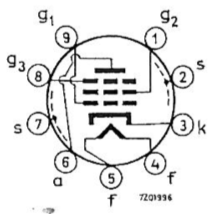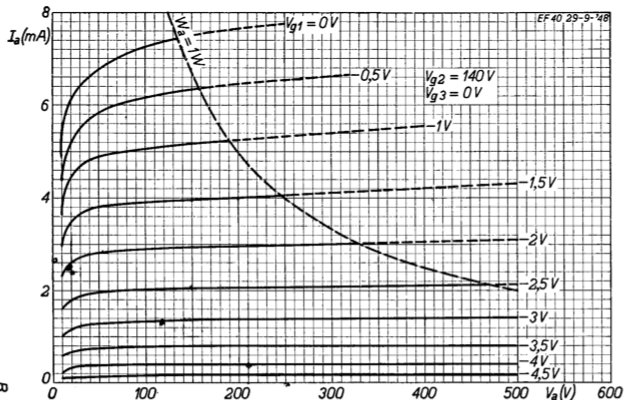EF86 Pentode
The EF86 tube used in the AC5 is an Electro-Harmonix tube, manufactured in the old Sovjet-era tube factory in Saratov, Russia. Not that many tube factories exists nowadays, and most brands are actually rebranded tubes from one of a very few still existing factories.
The pinout and most fundamental characteristics can be found in the EHX EF86 datasheet:

| Pin | Name | Description |
|---|---|---|
| 1 | g2 | Screen grid |
| 2 | s | Screen (chassis ground screen) |
| 3 | k | Cathode |
| 4 | f | Filament heater pin |
| 5 | f | Filament heater pin |
| 6 | a | Anode (plate) |
| 7 | s | Screen (chassis ground screen) |
| 8 | g3 | Suppressor grid |
| 9 | g1 | Control grid |
Unfortunately, the datasheet doesn’t provide a diagram with the static anode characteristic curves. A lot of datasheets can be found via the duncanamps.com datasheet search engine. This search results in a peculiar result: the EHX EF86 datasheets seems the be copied from a Philips EF86 datasheet! An older version of this datasheet actually has some diagrams, and it is this datasheet that has actually been used by the VOX designer of the original AC4/AC15.

Sidenote: the figure is from the EF86 datasheet, but it states EF40. The EF40 is the precursor to the EF86, electronically they are the same.
EF86 tube analysis
For tube analyses, the diagram below gives the usual structure.
The result of this analyses, when plotting the current of the Anode, gives:
The duncanamps SPICE model was used for this simulation and is considered to be one of the best versions. However: it differs a bit from the diagram out of the Philips datasheet (which is actually dated at 1948 (!)), so who knows which version is more correct with respect to the EHX EF86…

